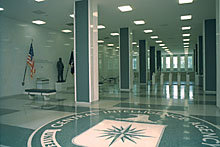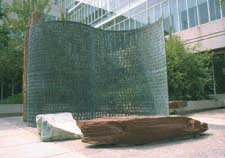 1997 Factbook on Intelligence
1997 Factbook on Intelligence 1997 Factbook on Intelligence
1997 Factbook on Intelligence

The New Headquarters Building was designed in the early 1980s by the Detroit architectural and engineering firm of Smith, Hinchman & Grylls. The new building is joined to the west facade of the original building and includes two six-story office towers connected by a four-story core area. It is a steel and glass structure as compared to the precast concrete construction of the original building.
The original building consists of 1,400,000 square feet, and the new building contains 1,100,000 square feet of space. Buildings and grounds comprise 258 acres.

Etched into the wall of the original building's central lobby is a biblical verse which also characterizes the intelligence mission in a free society. It reads:
Art works purchased from and loaned by the late Vincent Melzac from his private collection are on the first floor of the Original Headquarters Building and the second and third floors of the New Headquarters Building. Mr. Melzac was one of the earliest collectors of Washington Color School art and was former director of the Corcoran Gallery. He also donated the original bust of George Bush, sculpted by Marc Mellon, which is located in the Exhibit Hall in the original building.
Mounted on the wall of the fourth floor lobby is a plaque showing a three-quarter facial image of former Director William J. Casey. The image is sculpted in green serpentine stone from Buckingham, Virginia.
Throughout the headquarters buildings, original art can be found in the form of sculptured busts, bas-reliefs, and plaques. Oil portraits of each Director line one hallway.

There are three sculptures on the grounds. One is of Nathan Hale, done by Bela Lyon Pratt, and another, "Kryptos," by James Sanborn, incorporates native American materials with a theme of information gathering. Sanborn's sculpture includes an encoded copper screen. A sculpture memorializing the fall of the Berlin Wall was dedicated on 18 December 1992.
The Fine Arts Commission ensures compliance with principles set forth by the General Services Administration and the National Endowment for the Arts.
The auditorium has some 7,000 square feet of floor space and seats 500 people. Its stage contains a projection screen that rises from and disappears into the floor. The auditorium's lighting system is supplemented with side and rear lights to accommodate the use of color television cameras and motion picture filming. Large plaster rings on the inside surface of the dome enhance both the aesthetic and acoustical characteristics of the structure. Listening devices are available for individuals who are hearing impaired.